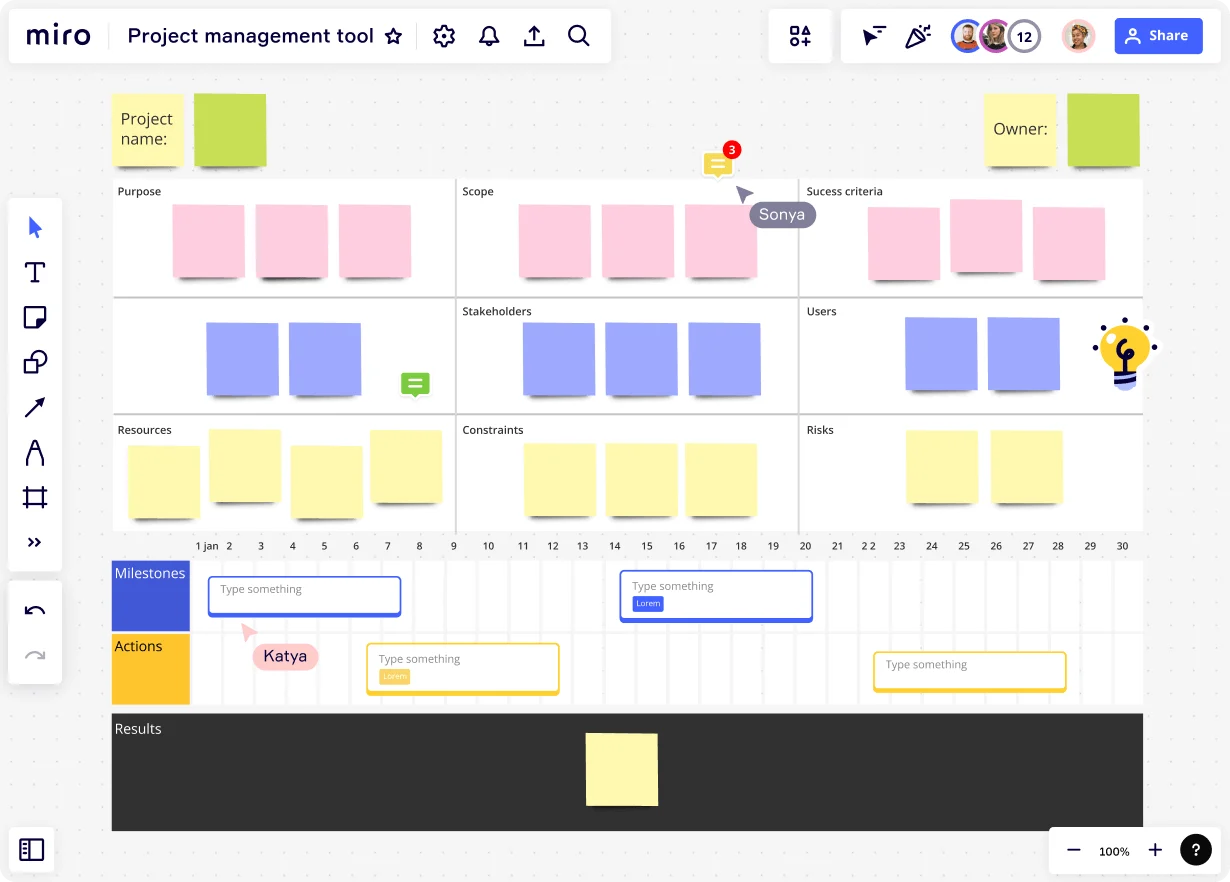
Table of contents
Table of contents
What is a release plan?

Summary
In this guide, you will learn:
- What a release plan is and its role in coordinating development, testing, and deployment for a product launch
- Key components: SMART goals, prioritizing features, and defining milestones/deliverables
- Agile release planning approach: vision, backlog prioritization, and sprint planning
- Distinction between product roadmap and release plan: detail, time horizon, and audience
- How to use Miro templates to visualize, prioritize, and collaborate on release plans/product roadmaps
- Best practices for flexibility and alignment during release planning
Try Miro now
Join thousands of teams using Miro to do their best work yet.
Introduction to release plans
A release plan plays a vital role in successful project management. By effectively coordinating the development, testing, and deployment activities, it ensures smooth product launches. In this comprehensive guide, we will delve into the key concepts and best practices of release planning.
Definition of a Release Plan
What is a release plan? A release plan is a strategic document that outlines the schedule and scope of activities involved in bringing a product to market.
It serves as a roadmap, guiding the entire project team through the development and release process. The primary objectives of a release plan include:
1. Defining clear goals and objectives for the product launch.
2. Identifying and prioritizing features, tasks, and milestones.
3. Establishing timelines and allocating resources effectively.
Key Components of a Release Plan
To create a successful release plan, several key components should be considered:
1. Goals and Objectives:
• Clearly define the purpose and desired outcomes of the release.
• Set specific, measurable, attainable, relevant, and time-bound (SMART) goals.
2. Feature Prioritization:
• Identify and prioritize product features based on customer needs and market demands.
• Use techniques like MoSCoW (Must have, Should have, Could have, Won't have) to prioritize features.
3. Milestones and Deliverables:
• Define key milestones and deliverables that mark significant progress or achievements.
• Break the release into manageable phases to monitor and track progress effectively.
Creating a Release Plan
To create an effective release plan, follow these steps:
Step 1: Gather Requirements and Define Scope
• Conduct thorough market research and collect user feedback to understand customer needs.
• Clearly define the scope of the release, including the desired functionalities and target audience.
Step 2: Establish Timelines and Allocate Resources
• Develop a detailed timeline that includes development, testing, and deployment phases.
• Allocate resources, such as development teams, testers, and infrastructure, based on project requirements.
Step 3: Risk Management and Contingency Planning
• Identify potential risks and develop contingency plans to mitigate them.
• Regularly assess and update risk mitigation strategies throughout the release process.
Best Practices for Release Planning
Implementing best practices can greatly enhance the effectiveness of your release plan:
Collaboration and Communication:
• Foster open communication and collaboration among team members, stakeholders, and departments.
• Maintain regular status meetings and ensure everyone is aligned with the release goals.
Continuous Integration and Testing:
• Embrace continuous integration and automated testing to catch issues early in the development cycle.
• Implement robust quality assurance processes to ensure a stable and reliable release.
Documentation and Knowledge Management:
• Document all aspects of the release plan, including requirements, processes, and decisions.
• Create a centralized knowledge repository to store and share relevant information among team members.
Benefits of Using Release Plans
Implementing a well-structured release plan brings numerous benefits:
Streamlined Development and Deployment:
A release plan helps coordinate development and deployment activities, ensuring smooth execution. It minimizes delays, improves efficiency, and increases the chances of meeting project deadlines.
Enhanced Product Quality: By incorporating thorough testing and quality assurance processes, a release plan ensures a high-quality product. It reduces the risk of critical issues and increases customer satisfaction.
Improved Collaboration and Stakeholder Alignment:
A release plan promotes collaboration and aligns stakeholders with project goals and timelines. It creates transparency, fosters trust, and enhances overall project communication.
Conclusion
In conclusion, a release plan is a crucial tool for successful project management. By defining clear goals, prioritizing features, and effectively managing resources, it enables organizations to launch products seamlessly.
By following the best practices outlined in this guide, you can unlock the power of release planning and drive successful product launches.
Author: Miro Team
Last update: October 16, 2025